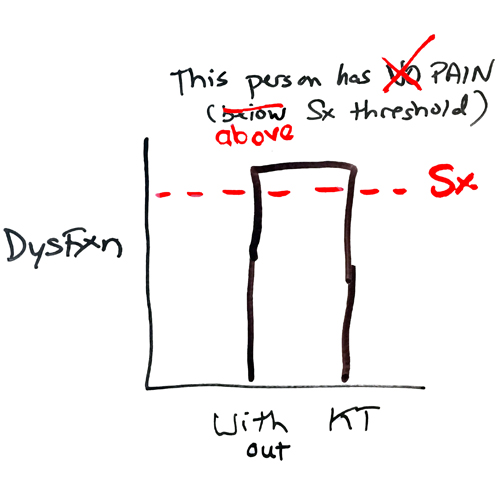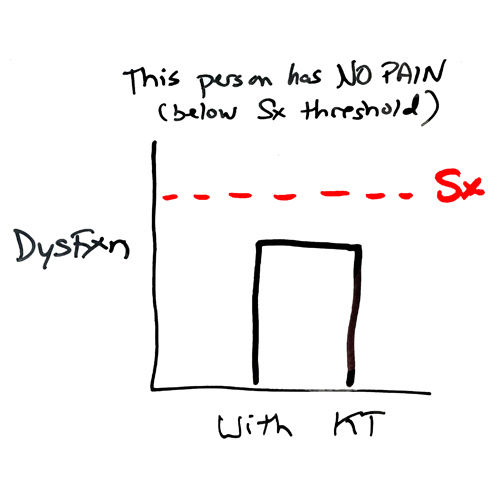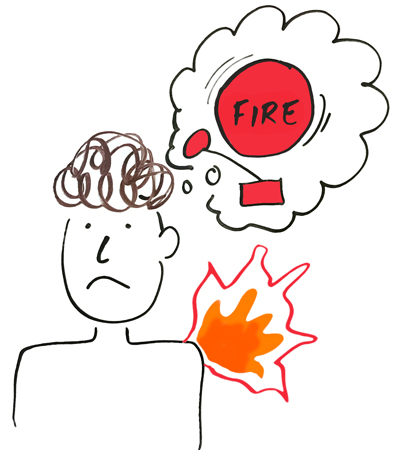18 Aug The Truth About KinesioTape: Olympic Athletes and You
Note: This post is meant to be long + educational on KinesioTape. Proceed at your own time expense.
If an Olympic athlete jumped off a bridge, would you do it too?
KinesioTape is big these days.
It’s all over the Olympics, the NFL, + pro-cycling. It’s been worn by professional athletes such as Green Bay Packers, the Houstan Texans, and Lance Armstrong.
Just because a professional athlete wears it doesn’t mean it’s good for your health.
The Power of Symptom Reducers
Riddle me this.
If something reduces the intensity of your pain, is the problem gone?
My best friend and roommate at Franklin & Marshall College (nick-named “T” because he used to cry when he struck out in t-ball as a child) was a fantastic football player + a wing nut of a human being who caused one heck of a ruckus in school.
This was the guy who would take any bet you put in front of him when asked in a sarcastic tone, knowing that he’d try to accomplish the action:
T, you can’t lift 1000 pounds!
T, you won’t light your hair on fire!
T, you won’t fight that entire fraternity with two other guys by your side!
T, you won’t try the milk gallon challenge! (He would try … and fail … twice. You can imagine what happens when you fail at chugging a gallon of milk in an hour … it’s not pretty.)
Hopefully, you have a decent picture of the shenanigans of this guy.
I mention that he was a good football player because he also happened to tear his A.C.L. on three different occasions in college.
T tore his A.C.L. for the third time during his first rugby practice when I asked him to come out for rugby with me. Sorry roomie.
On the earlier second occasion, T couldn’t walk after our football game at dear ‘ol F&M. His A.C.L. was gone, which means he had no anterior knee stability.
The thing about alcohol is that it numbs things. The thing about adrenaline is that it makes you do things you shouldn’t be able to do.
Half a case of beer and another gut check (“T, you can’t run without an A.C.L.!”) later, T is sprinting through the dorm halls, wrestling five other football players, moving like the All-American football player he should have been.
Finally, he woke up the next day in way MORE MASSIVE pain (a sign that he put load or stress on already damaged tissue) than he’d been when he’d torn it a day earlier, not having any recollection of the night before.
Well T, you ass, you were sprinting around the halls like Batman with Gotham City to save!
Lesson Learned: Alcohol makes pain go away. So does ice and adrenaline. Kinesiotape does too.
Not one of these solutions is good for your health as evidenced by the way you are asking an injured area of your body to do work. But if athletic performance or reduced symptoms are your goal, then use away.
On Effectiveness – The Research on KinesioTape
Before I fully address the “health” component, first I’m going to downplay the effectiveness of KinesioTape.
Here’s some of the research.
Generally, the only thing most studies agree on is a decrease in symptoms + an increase in pain-free range of motion (ROM) or strength, all of it, temporary:
- In one study diagnosing shoulder pain patients with “rotator cuff tendonitis” or “shoulder impingement” (2), KinesioTape was effective at increasing immediate pain-free range of motion overhead, but nothing over the long term.
- In another 2012 review of several studies using kinesiotape (3), there was minimal evidence of any positive effect using KinesioTape over traditional non-elastic tape.
- KinesioTape does not affect neuromuscular performance in healthy subjects (4).
- KinesioTape does get immediate results as far as increased ROM and decreased pain, but over the long term, these results are not significant compared with the control group (5).
- Both cervical manipulations and KinesioTape reduced pain in cervical neck pain patients (6). An interesting observation about this study is pointed out below.
But this brings us to an interesting point: The authors stated in the abstract:
(6) Because we did not include a control or placebo group in this study, we cannot rule out a placebo effect or natural changes over time as potential reasons for the improvements measured in both groups. [the bold is mine]
The above comment is my BIGGEST PROBLEM with any chosen modality in the face of acute pain (or pain that began a brief time ago). The vast majority of acute pain conditions will feel better no matter what tool you choose to fix it, even if it’s sham modalities such as me giving you a “wet willie” (How to) or even a “noogie” (How to).
That’s why at Barefoot Rehab, we like to focus on treating chronic pain. When someone has had pain for months or years, he knows that the pain going away was not caused by the natural history of the condition, but by effective treatment.
On Health – Let’s Play Red Light – Green Light
 Here’s why KinesioTape might help momentarily reduce pain at the cost of your health.
Here’s why KinesioTape might help momentarily reduce pain at the cost of your health.
Did you ever play “Red Light – Green Light” when you were little?
That’s ok if you didn’t, because we’re going to play right now.
When your body is fresh, healthy + damage-free, you experience no pain. Your subconscious brain tells your musculoskeletal system:
Green Light!
Go, move, do as you wish.
As your body accumulates load + stress by doing work, your bucket starts to fill up as your body begins to put the brakes on your muscles:
Yellow Light!
Slow down buddy.
When a body part is damaged, you experience pain. Your subconscious brain tells your musculoskeletal system:
Red Light!
Don’t go, don’t move! And if you do, compensate!
That’s why you limp when you sprain your ankle.
Or why you can hardly bend forward if your “back is out” when you could touch your toes the day before.
Your hamstrings just didn’t get a boatload of adhesion in one day. Your brain is using your hamstrings as a protective mechanism to take stress off of a damaged disc! This is a nervous system phenomenon.
Let’s come full circle back to the KinesioTape …
In one of the larger KinesioTape reviews from above (3), the authors observed that:
KinesioTape can increase pain-free ROM + strength when applied, but that it was not known whether that increase in ROM or strength was beneficial or harmful to the body. [the bold is mine]
If you have tissue damage, your body will compensate with decreased ROM or increased pain. If you apply some tape to the injured area, you (may) immediately have decreased pain or increased ROM or strength.
Or in other words …
You’ve artificially green-lighted a red light! Picture an intersection with four green lights causing a crash right in the middle.
Imagine you have a torn labrum in your shoulder. You are not able to lift your arm overhead – this is your brain protecting you with pain.
If you do not wear KinesioTape, you will continue to be in pain. Notice in the graph below, the person’s dysfunction is above the symptom threshold. (If you need to read our introductory dysfunction on the definition of dysfunctions, you can do so here). In this case, the nervous system’s ability to percieve what is going on with the damaged tissue is clear + true.

But if apply a little tape, “Oh, now you can move overhead!”
You’ve immediately brought your dysfunction underneath the symptom threshold by activating neurological reflexes. In this case, the nervous system’s ability to perceive is cloudied (yes, “to cloudy” is a real verb now) by a therapy that is not dysfunction-reducing.

Whoops! without a nervous system in integrity, you’re continuing to load a damaged labrum. Now it’s doubly-damaged.
Your labrum is sad.
Not very smart.
On Athletic Performance – What is Your Goal For Treatment?
One of my chiropractic mentors had a son who fractured a leg bone in a skiing accident. As the doctors went to apply morphine into his IV, the father said: “No medication. He took an action that caused the fracture to happen. He needs to remember what the consequences of his actions are.”
While a quite harsh, there’s a lot of truth to owning the pain we put out bodies through.
Here’s my simple guideline:
Pain is there for a reason, as a signal from your nervous system to your conscious mind that there is tissue damage.
Don’t turn off the fire alarm, put out the fire.

Your choice for a certain tool needs to keep in mind whether “health” or “athletic performance” is your goal.
If you value your health, I don’t advise turning off the fire alarm and using KinesioTape, ice, pain medications, drugs, or alcohol.
If you are an athlete that values your performance more than your health, then turn off the fire alarm if you wish, but realize the consequences.
The cost to these treatments is that you do not heal to the full extent that your immune system is capable of. And you can damage something irreparably.
Remember the 1999 Texas high school football drama Varsity Blues where star quarterback Lance is manipulated into taking cortisone shots in his knee so that he can play, only to have medical doctors find enormous amounts of scar tissue in his knee from neglect? Watch the scene here.
Heck, I used to take adderall before football games (yes, that’s the ADHD medication, which is very similar to cocaine). Taking that stuff, I could run through a brick wall and therefore, perform better as a linebacker.
That doesn’t mean it was good for my health.
Conclusion
NFL athletes are playing for money. Olympians play for glory.
The vast majority of the population, including weekend warriors, Crossfitters, and those of us just trying to stay healthy, are playing for neither.
Kinesio Tape can help reduce pain, but it comes at the cost of your health.
Because this may be the only body you receive, always perform a COST-BENEFIT ANALYSIS of any specific treatment.
Your life and health deserve the thought.
 What has your experience been with KinesioTape or other tapes? Rocktape? Athletic tape? What are your thoughts on other pain or soreness-reducing modalities? Ice? Heat? Cupping? etc.
What has your experience been with KinesioTape or other tapes? Rocktape? Athletic tape? What are your thoughts on other pain or soreness-reducing modalities? Ice? Heat? Cupping? etc.
Resources
1. See Reason #4 in 8 Reasons People Do Dumb Things (t-nation.com)

No Comments